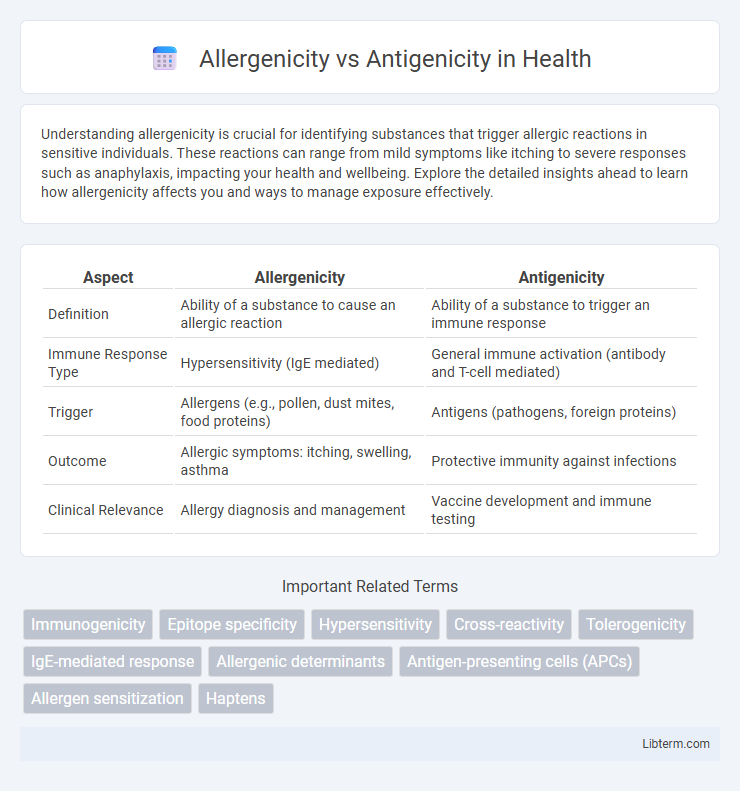Understanding allergenicity is crucial for identifying substances that trigger allergic reactions in sensitive individuals. These reactions can range from mild symptoms like itching to severe responses such as anaphylaxis, impacting your health and wellbeing. Explore the detailed insights ahead to learn how allergenicity affects you and ways to manage exposure effectively.
Table of Comparison
| Aspect | Allergenicity | Antigenicity |
|---|---|---|
| Definition | Ability of a substance to cause an allergic reaction | Ability of a substance to trigger an immune response |
| Immune Response Type | Hypersensitivity (IgE mediated) | General immune activation (antibody and T-cell mediated) |
| Trigger | Allergens (e.g., pollen, dust mites, food proteins) | Antigens (pathogens, foreign proteins) |
| Outcome | Allergic symptoms: itching, swelling, asthma | Protective immunity against infections |
| Clinical Relevance | Allergy diagnosis and management | Vaccine development and immune testing |
Introduction to Allergenicity and Antigenicity
Allergenicity refers to the capacity of a substance, known as an allergen, to trigger an allergic response by stimulating an immune reaction primarily involving Immunoglobulin E (IgE) antibodies. Antigenicity describes the ability of a substance to bind specifically with immune receptors, including antibodies or T-cell receptors, thus initiating an immune response that may or may not lead to allergy. Understanding the differences in molecular structures and immune mechanisms underlying allergenicity and antigenicity is crucial for advancements in immunotherapy and allergy diagnostics.
Defining Allergenicity: What Makes a Substance an Allergen?
Allergenicity refers to the capacity of a substance to provoke an allergic immune response, primarily mediated by IgE antibodies recognizing specific proteins as harmful. A substance is defined as an allergen when it possesses structural features--such as certain proteins or glycoproteins--that are capable of binding to IgE and triggering mast cell and basophil activation, leading to allergy symptoms. Factors influencing allergenicity include molecular size, stability, enzymatic activity, and the ability to cross epithelial barriers to sensitize susceptible individuals.
Understanding Antigenicity: The Basis of Immune Recognition
Antigenicity refers to the ability of a molecule, typically a protein or polysaccharide, to bind specifically to immune receptors such as antibodies or T-cell receptors, triggering immune recognition. This property underlies the immune system's capacity to distinguish self from non-self, enabling defense against pathogens. Understanding antigenicity involves studying epitopes, the precise molecular structures recognized by immune cells, which informs vaccine design and immunotherapy development.
Key Differences Between Allergenicity and Antigenicity
Allergenicity refers to the ability of a substance to cause allergic reactions by triggering an immune hypersensitivity, whereas antigenicity denotes the capacity of a molecule to bind specifically with antibodies or T-cell receptors, initiating an immune response. Key differences include that allergenicity involves hypersensitivity reactions primarily mediated by IgE antibodies, while antigenicity encompasses a broader immune recognition process involving various antibody classes and T-cell activation. Allergenic substances are a subset of antigens, distinguished by their propensity to provoke allergic symptoms such as asthma, anaphylaxis, or rhinitis in sensitized individuals.
Mechanisms Behind Allergenicity
Allergenicity refers to the ability of a substance to trigger an allergic immune response, primarily involving the production of IgE antibodies and activation of mast cells and basophils, leading to symptoms such as inflammation and histamine release. The mechanisms behind allergenicity include the recognition of specific protein epitopes by antigen-presenting cells, which process and present allergens to T-helper 2 (Th2) cells, promoting a type 2 immune response characterized by elevated cytokines like IL-4, IL-5, and IL-13. Antigenicity is the broader capacity of a substance to bind to specific antibodies or T-cell receptors without necessarily causing an allergic reaction, differentiating it from allergenicity based on the nature of the immune response elicited.
Factors Influencing Antigenicity
Antigenicity is influenced by factors such as the molecular size, complexity, and foreignness of a substance, which determine its ability to be recognized by the immune system. Protein structure, epitope availability, and the presence of adjuvants also play critical roles in enhancing antigenic response. Unlike allergenicity, which specifically relates to allergic hypersensitivity reactions, antigenicity encompasses broader immune recognition, influenced by genetic and environmental factors.
Clinical Implications: Allergic Reactions vs Immune Responses
Allergenicity refers to the potential of a substance to cause allergic reactions, characterized by IgE-mediated hypersensitivity leading to symptoms such as urticaria, anaphylaxis, and asthma. Antigenicity describes the ability of a molecule to elicit a broader immune response, including antibody production and T-cell activation, which may not always result in allergy but is crucial for pathogen defense and vaccine efficacy. Understanding the distinction between allergenicity and antigenicity guides clinical decision-making in allergy diagnosis, immunotherapy, and the management of immune-mediated diseases.
Diagnostic Approaches to Allergenicity and Antigenicity
Diagnostic approaches to allergenicity primarily involve skin prick tests, specific IgE measurement, and basophil activation tests to identify hypersensitivity reactions to allergens. Antigenicity diagnosis incorporates enzyme-linked immunosorbent assays (ELISA), Western blotting, and immunohistochemistry to detect immune responses triggered by antigens. Advanced molecular techniques like component-resolved diagnostics (CRD) enhance the specificity of allergen and antigen detection, improving personalized management of allergic and immune-mediated conditions.
Managing and Reducing Allergenicity in Everyday Life
Managing allergenicity in everyday life involves identifying and minimizing exposure to common allergens such as pollen, dust mites, pet dander, and certain foods. Strategies include using HEPA filters, regularly cleaning bedding and upholstery, maintaining low indoor humidity, and choosing hypoallergenic products to reduce immune system reactions. Understanding the difference between allergenicity--the potential to cause allergic reactions--and antigenicity--the ability to bind specifically to immune components--helps tailor effective prevention and treatment plans.
Future Research Directions in Allergenicity and Antigenicity
Future research directions in allergenicity and antigenicity emphasize the development of advanced molecular techniques such as CRISPR gene editing and high-throughput sequencing to identify novel allergenic epitopes and immune-reactive antigens. Integrating bioinformatics tools with immunoinformatics is pivotal for predictive modeling of allergen-antigen interactions and improving vaccine design. Emerging studies also prioritize personalized medicine approaches to tailor allergy treatments based on individual antigenic profiles and immune response variability.
Allergenicity Infographic

 libterm.com
libterm.com